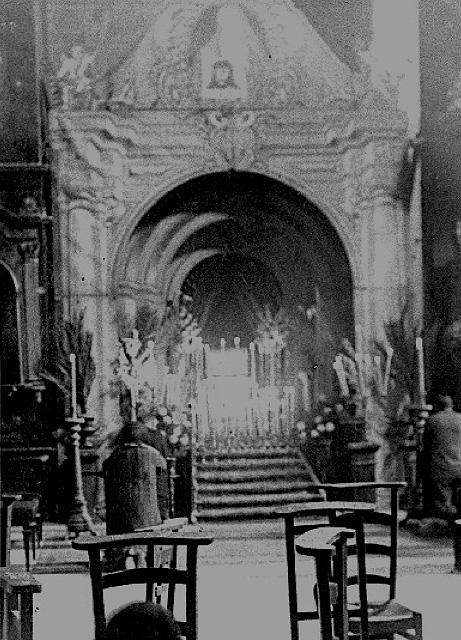The piece of the month of June 2011
THE MONUMENT OF PERSPECTIVE OF THE PARISH OF PERALTA
Ricardo Fernández Gracia
Chair of Navarrese Heritage and Art
To the kindness and generosity of the parish priest of Peralta, Don Francisco Javier Leoz, we owe the knowledge of the existence of the photograph that accompanies this text. The image is exceptional not for the piece itself, but for its genre in Navarra, where this subject of scenographies stopped being mounted in the fifties and sixties of the last century and its snapshots are practically a rara avis.
As is well known, the Holy Week monuments were placed for the Holy Thursday liturgy. Throughout the eighteenth century they were mostly made with decreasing arches in depth and the last of perspective, collecting the rich experiences of the Italian masters and their works, mainly Bernini, Borromini and Father Pozzo, as well as various designs of some treatises on perspective.
Professor Echeverría Goñi studied this typology in Navarre and even published some traces ("Los monumentos o "perspectivas" en la escenografía del siglo XVIII de las grandes villas de la Ribera estellesa". Príncipe de Viana (1990). The designs of many of them are found with the deeds of their contracts and others ended up, due to lawsuits, at file Diocesan of Pamplona. In this last one is conserved the project of the monument of perspective of Garinoain, built by the masters José de Ruete, painter and Antonio de Bellostas, architect.

Photograph of the Monument of the parish of Peralta. 1942
The one that concerns us in Peralta was contracted in 1781 with the painter of Tafalla José del Rey, a prolific master who made other works of this subject and above all gilded and polychrome numerous works, throughout the second half of the eighteenth century. After the completion of the project, in 1782, it was recognized and appraised by the Italian master Santiago Marsili, established in those years in the town of Peralta, giving it for well done and warning that the designs for its execution had been made by the Riojan painter José Bexes (1729-1785), surely taking advantage of his stay in the Navarrese town in order to polychrome the lateral wings of the main altarpiece that he had contracted in 1780.
If we take into account that Bexes himself became position of the monument of the parish of San Saturnino de Pamplona between 1778 and 1779, destroyed in 1928, we can imagine with that of Peralta how was that of the parish of Pamplona, in the scale of the bishopric the first of the diocese. Once again, the people of Peralta, like the people who held other patronages in singular towns such as Los Arcos, spared no effort to find the best of the best. In the case at hand, the person who was very aware of everything that was done in the parish of Peralta - organ case, pulpits, altarpieces, outstanding works of embroidery, etc. - was Don Tomás de Marichalar. His name appears in all the initiatives that took place in the town, particularly with regard to the ornamentation of the church and divine worship. He himself left written in his will that he had taken care, like his ancestors, of the accounts of the parish's first fruits, with an interest and zeal for everything related to divine worship.
The same personage, from his public responsibility as governor of justice of Peralta, stood out as a person of the Age of Enlightenment and a man very much in tune with the enlightened policy of reforms everywhere. Whoever reads his proclamations for the local festivities, Holy Week, and others on the occasion of various events, can only evoke the great principles of reform that prevailed in the Spain of Charles III.
The photograph of the Peralta monument indicates on the back that it was no longer mounted in the middle of the last century. A registration reads: "This monument was placed in the chapel of San José of the parish of San Juan Evangelista de Peralta and was used for the last time on Holy Thursday 1942". The date will coincide with that of the photograph for reasons that seem obvious.
Like other monuments of perspective, we find some canvases held by their frames on which architecture and some figures have been painted, among which the Veronica with the Holy Face and possibly angels with the arma Christi stand out. The illusory perspective is achieved through the multiplication of pillars and decreasing arches that lead the gaze towards the tabernacle, in the case of Peralta a very rich silver chest of Peruvian origin datable to the decade of the twenties of the eighteenth century and possibly given by an Indian of the Irigaray family.
In reality, it was a false perspective that, when examined closely, like many others, would turn out to be much shorter than it appeared, because the order of the columns became shorter as it moved away from the viewer. The world of illusion has been part of the essence of painting since ancient times, so much so that it is an ingredient of its history. The usual concept of painting, in the past, is the figuration on a two-dimensional surface of the spatial effect in its entirety, using the rules of optics and perspective.
Illusionism and trompe l'oeil already belong to classical times, while Greek painters were inclined to trompe l'oeil, Romans did it by the ways of spatial illusionism. Perspective is a system of representation of a three-dimensional object or space on a flat surface, as it appears to the eyes of an observer from a certain point of view. Architectural illusionism is something that adds to a reality, making it more grandiose, imaginative and monumental. It can be said that it enlarges the architecture to which it is applied.
